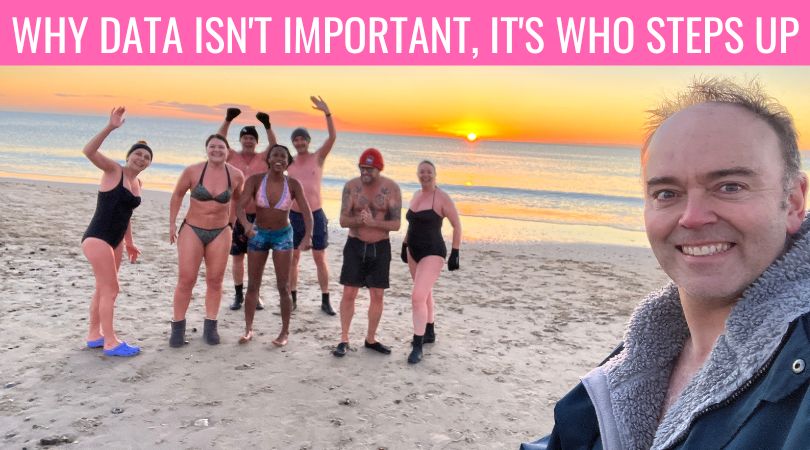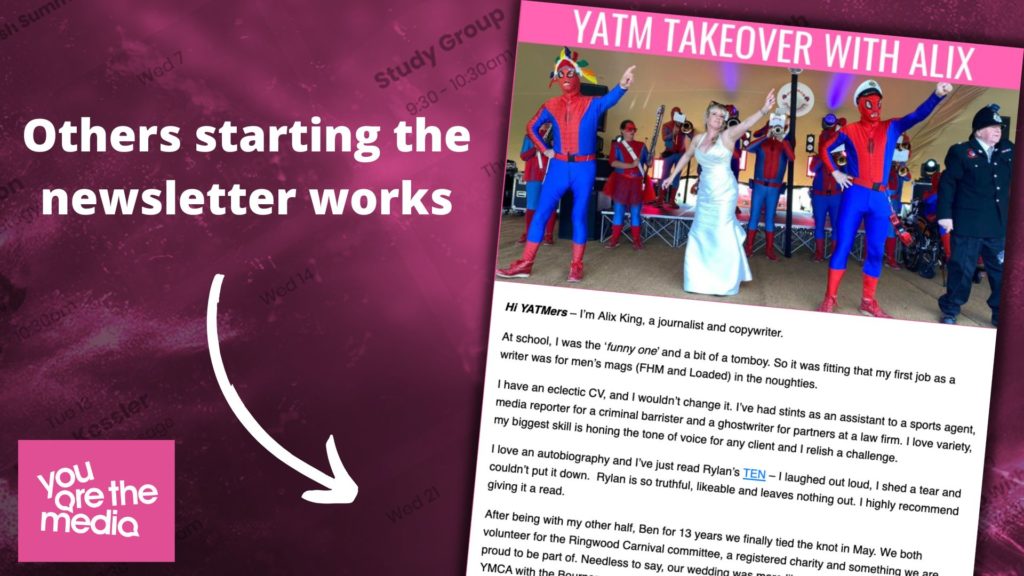Beyond Numbers: The Power of An Opt-In Audience

Data isn’t everything. The significance of the people who commit to your work is what matters.
You can measure down to the tiniest of detail, but if your world is just measured by numbers then it takes away the creativity of making meaningful connections as you’re always striving to affect the numbers in some way.
It’s important to know customer journeys, whether your website is drawing people to it and what they do when they arrive. Then again, you see numbers, not people. Just because someone visits your website or watched a video, the world is not your audience. It’s about making your work relevant for the people who matter.
Relying solely on data-driven decisions can limit creativity and hinder the ability to establish genuine connections.
This article is about realising that data isn’t everything, but the people who opt-in is.
My experience
I recently updated my analytics to Google Analytics 4. There has been a lot of furor around updating to the new version for the 1st July deadline. Being data-driven has taken centre stage recently for many people and businesses.
I did it, but know that I’ve never been swayed by traffic and data from Google Analytics.
It’s hypnotic when Google tells you you can measure clicks, views, bounces, time and engagement. You can see where people leave and lean into conversion funnels. You can measure CR, CTR, KPI, PV, UV and CLV.
You can allow Google to take care of everything for you, but as Seth Godin said, ‘Google is not your friend, it’s a tool.’
Time to raise my hand and say that I have never been transfixed by Google Analytics. What matters to me is how numbers become people. I am focused on my subscribers and what they do and how the work I produce is useful to them, that is what matters to me.
It’s never been about onlookers, spectators and strangers, but what you do with the people who commit. It’s then over to you, to make the experience stronger than anything else they can find out there. Produce work that is valuable to them, then analyse and refine.
This to me is where the data starts. What matters is the audience who opt-in. These are the people who allow you to contact them directly without a middleman or third party of a much bigger platform.
When your focus shifts from the industry you represent to the audience you have, their attention shifts towards you.
Going Beyond Data-Led Decisions
You can’t use numbers as your sole source of guidance. Just because you had a spike of visitors to watch a video or visit a website page, were they the right people?
Relying solely on the data leads to a lack of creative ingenuity and helping you on a path of ideas and relevant insights. It helps when you get down to seeing those around you such as asking questions and getting feedback from the people who chose to be with you (from subscribers to customers).
Analytics and numbers are not the reference point for your answers. Just because the stats said X, doesn’t mean you have to do X.
The wisdom of what you’ve already done doesn’t mean it’s the straight path to how you should proceed. As an example, my most popular post of all time is irrelevant to me. It’s called ‘do you buy Christmas presents for customers’ (from 2013). Around November to December every year, this is my Christmas hit. If I leaned into this, I’d be producing ideas for thrifty people with customers. The people who click on this are not interested in what it takes to build their own audience.
Using this example highlights the people who are exposed to your work (a potential audience) versus the people who are connected, so you can reach out to them again (your actual audience).
Your actual audience is where the data starts to be balanced with creativity and sparks to explore together.
The Value Of The People Who Opt In
Rather than obsessing over strangers and numbers, heighten the impact of the work you do for the audience who care about your work (and you care about them).
As an aside when it comes to getting people to opt-in, this is a framework I use for subscribers, read ‘how to get your first committed newsletter subscribers’. This answers the question on where do subscribers arrive from to YATM, before I start to figure out with those who come inside.
When it comes to knowing which place a person arrives from, I ask them. I do this via a video message I send to new subscribers. By understanding their starting place it helps to be that bridge to welcome someone in.
This is the power of an opted-in audience where it provides you with the opportunity to establish a committed relationship, that can even become a friendship.
Pushing Creativity, Not Data Overdrive
To get the data you want, it’s not about analysing how everyone comes to you, but becoming irreplaceable in the eyes of your audience.
You can then tailor your work to your values and how that connects with others. It’s about others leaving their fingerprints on your work, so you can see who they are and then pay more attention to the right people. Forget the tyre kickers and time wasters
The means of bringing people to you ie. newsletter, events, membership, is there to amplify the ways we come together and see each other. Analytics is there to follow and track people. It’s about unlocking the full potential of the people around you and addressing the needs of those you aim to serve. This helps focus as well as save time.
Ways To Measure What Has Meaning
While data gives you insights, it’s what you do when people arrive and commit that is important.
Specificity in your offerings, clear hooks and persistence with your work make an impact and a committed and engaged audience.
Here are some examples of the data that helps me, so I can refine and make it better:
Recognise the places people click on the weekly newsletter
This helps me focus on what works and what to leave out. For instance, I tested out the idea of featuring others from the YATM community in January 2020, and it worked and this now becomes the second most clicked part of the newsletter (after the main article).

See what themes resonate
Looking at the newsletter stats I can see what topics resonate the most. Themes around community, testing/experimentation and homemade v AI are popular for 2023. This means I can pick up threads and explore deeper. This is about creating and exploring ideas for a tuned-in audience. It also means you don’t have to continually be reinventing the wheel.
The paths to purchase
I use the newsletter to sell relevant products to the audience, it helps when it follows the flow of the newsletter. I can see what works from either being direct or more subtle within the email. This works better than social posts as I can see that days for buying are skewed to when the newsletter is sent.
See what subject lines work (so people open)
One thing I have noticed is that shorter subject lines work, so I try to keep them as succinct as I can. Emojis do not matter, but what I have seen over the years is that the sender of the newsletter is more important than a headline. This comes down to trust and the mutual exchange between you and someone else (so always use yourname@ and never a generic info@)
Adapt how people prefer to read
The weekly YATM newsletter is now shorter and I have taken 1,500+ word articles out of the newsletter and invited people to click on the link. What I now do is provide a short summary of the article and then a question for people to consider that relates to their work and to action on their side. I only discovered this from people who were saying that their emails were being cut off towards the end.
Respond to ideas and feedback from subscribers
Reactions and thoughts from others are important. If you ignore an email, it’s a wasted opportunity as could help ignite an idea. Someone else has put the time in to send and even a small acknowledgment that they are seen is better than ignoring them.
Asking people what they think
I did this a lot with the build-up to the launch of the YATM Club where I had to take on the feedback from others. It meant I took a lot longer from beta mode to launch, but the input was needed. What I originally thought would attract people to commit, was different from what the community actually said. Just talking to the right people can help make far stronger decisions.
Know what other media works in the newsletter
A newsletter doesn’t just have to be words. Over the years I have included audio and video. For instance, I included a link for people to listen to me read the weekly articles. From looking at the stats this was far fewer than the closing video at the end where I sum up the main article. I deleted the audio/podcast. This has helped me save additional time as wasn’t part of the newsletter that people interacted with.
When you create for the right people it helps you interpret the data with the decisions and the goals you want. The goal isn’t always to find more people but those who are committed to you to say, ‘this relates,’ or ‘I can do something with this’ or ‘I’m going to try something new.’
Let’s Round-Up
Data is a valuable tool, but it should not overshadow the significance of the people who commit to you.
By shifting your focus towards your audience, embracing their preferences, and infusing your creativity into your work, you can create meaningful connections that go beyond mere numbers. A committed relationship with your audience means you can track responses, preferences, and themes that resonate with them.
It’s time for us to recognise that data isn’t everything; it’s what we do with the people who choose to connect with us that truly counts.


